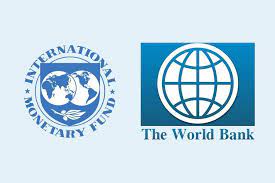I know new world order has become a loaded phrase these days with ideas of the great reset, etc, but I don’t have a better phrase to describe what the Bretton Woods Agreement did in July of 1944.
The institutions and policies reshaped the global financial system and continue to be the foundation of what we call market economies to this day. The phrase world trade system is also appropriate.
The principal outcomes of the Bretton Woods Agreement were the establishment of the International Monetary Fund (IMF), the establishment of the World Bank, and a system of currency convertibility that lasted from 1944 to 1971, and was replaced by floating exchange rates only after the US discontinued the gold standard.
The Bretton Woods Agreement also laid the foundation for the General Agreement on Tariffs and Trade (GATT) which in 1995 was changed into the World Trade Organization (WTO).
To this day the policies of the IMF, the World Bank, and the WTO drive global finance for what is called the western world.
————————————
This post is part of a larger series and sub-series.
Here is a link to the series: The history of banks and banking regulation
and to the sub-series: United States Banking and Bank Regulation History
————————————
Table of Contents
US Domestic banking also changed
The US response to world war 2 resulted in a stronger federal government, and closer cooperation between the Treasury and the Federal Reserve.
During the war, the Fed committed to low interest rates (2.5% for long-term bonds and 0.375% for 90-day bonds) for government bonds and they kept that target after the war.
Bear in mind that the Fed interest rate is the cost of money paid by the US treasury.
However, the lifting of wartime price controls, rationing, and the redemption of war bonds putting more cash into the hands of Americans, demand for things outstripped the supply of things, and inflation happened.
Dueling Fed targets
Now the Fed had two targets, working against each other.
The standard Fed tool to keep interest rates low is to increase banking reserves such that the demand for credit does not outstrip the supply of credit and cause the cost of credit (interest rates) to rise.
And the standard Fed tool to keep inflation low is to decrease banking reserves to dampen the demand for credit.
In 1947 the Fed and the Treasury agreed to let the interest rate on the short-term government bonds rise, but kept the 2.5% ceiling on the longer-term bonds.
In 1948 the Treasury ran a surplus, which eased pressure on the Fed but required the private sector (currency issuers) to run a deficit.
Fed requests new tools
Feeling a bit stuck between trying to manage between an interest rate target and an inflation rate target, the Fed asked Congress for the authority to raise reserve requirements and to impose reserve requirements on non-member banks. This was an attempt to constrain the growth of private credit without adjusting the amount of reserves.
The Fed further asked for the ability to restrict the types of government securities banks could sell to increase their reserve requirements, thereby allowing them to keep their government security holdings while simultaneously not allowing them to be used to increase reserves.
Somehow this ability to manage reserves in two different ways allowed the Fed to simultaneously keep interest rates low and keep inflation low.
Personally, from the perspective of constraining the growth of private credit, I don’t see how adding and subtracting reserves vs increasing and decreasing reserve requirements produce different outcomes, so if anyone does know, please clue me in.
However, Congress said no to the above requests.
But recessions change things
Recall that 1948 Treasury surplus I mentioned above? It required (or created) private sector deficits, and as currency issuer surplusses always do, it set up a recession, which occurred in 1949.
So, the fed loosed margin requirements (March), eased regulations on consumer installment credit (March and April) and reduced reserve requirements (May and again in August).
As the US had become the de facto provider of stuff other countries needed to rebuild after world after world war 2, and concerns about how the rebuilding of other countries could be affected by a US recession, Fed policy erred on the side of increasing the availability of private credit, which then showed up as inflation in 1950.
The additional need to provision the military for the Korean War also increased government spending.
The commitment of the Fed to simultaneously keep government bond interest rates (Treasury interest costs) low and target low inflation became too much. The dual targets were tugging Fed policy in two different directions.
And in March of 1951, the Fed and the Treasury reached an agreement that freed the Fed from its promise to keep government bond interest rates low.



